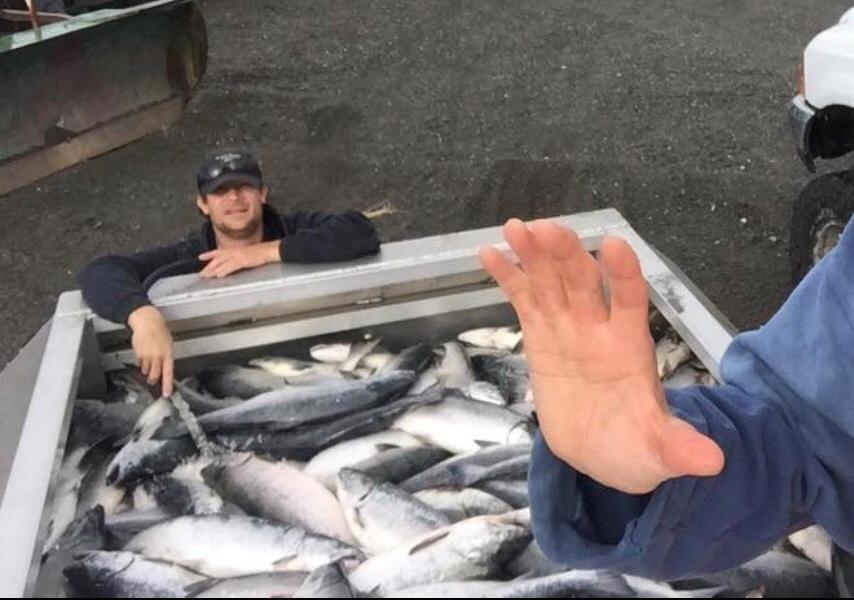
Bristol Bay’s coho fishery is often little more than icing on the cake for some sockeye fishermen who keep their nets wet through August. Due probably to the lack of participation, the catch is typically topped in the Southeast, Alaska Peninsula, Prince William Sound, Upper Cook Inlet and Kodiak fisheries, at least.
But this season the coho offered a surprising strong show, and an added market at Ekuk Beach gave westside fishermen new incentive to keep fishing after the sockeye run finally tapered off.
“This year we caught 175,000 coho, and that’s the second best since 1996,” ADF&G’s Tim Sands said of the Nushagak District.
Through Sunday, the total Bristol Bay coho catch had climbed past 210,000 as all the districts but Togiak wound down the commercial effort. By district, Egegik had 7,000 coho on the books, Naknek-Kvichak 3,000, the Ugashik catch is confidential based on limited buyers, and Togiak had 6,000.
The total Bristol Bay coho harvest was 91,000 in 2016; 37,000 in 2015; 287,000 in 2014; and 138,000 in 2013.
Most Bristol Bay buyers have wrapped up operations by the end of July on odd years, which are not the strong pink return years. But Copper River Seafoods has recently – and more important, consistently – offered drift fishermen a silvers market through August, and this year Alaska’s Best Seafood bought set net fish, especially from Ekuk Beach.
Still, there were not many who kept fishing.
“We don’t have a solid number on participation, because we just see numbers of deliveries, but I would guess maybe 50 people total, split between drift and set net,” Sands said.
Silvers fetched at least $.65 per pound, allowing for a lucrative tail end to an already record breaking year in the Nushagak for those who stuck it out. Among those happy to have done so is Lance Spencer, who partnered with the Boukers at Ekuk.
“I’ve fished silvers when there’s been markets here over the last 10 or 15 years and I haven’t seen a run like this,” Spencer said. “The fish really showed up. At some points it was similar to the peak of the red season with fish hitting the nets, nets loading up, and similar poundage on certain days.”
The work was steady for the past three weeks, not quite as blistering and frantic as the sockeye run, but achieved with a smaller crew. In the end, their total pounds in silvers rivaled a pretty good sockeye season, Spencer said, though it paled in comparison to their 2017 red catches.
Alaska’s Best Seafoods, a relatively new operation owned by Dillingham’s Jerry Ball, expanded this year and pledged to stay open through August.
“It started off with a little bit of complications, but it ended up doing real well for us, and they were able to take all our fish and get it off to market,” Spencer said.
Silvers have been thick in the Nushagak tributary rivers, to the delight of local anglers, hunters with time on their hands, and Bristol Bay’s sport fishing industry. Sands has taken plenty of reports on their abundance and taken note himself.
“We saw jumpers everywhere when we were upriver,” Sands said.
When the sockeye counting towers and sonar projects come down, ADF&G biologists use different formulas to gauge escapement, including anecdotal reports and eyeball estimates. For Sands, it was obvious the silver run was strong and there was not enough effort to create escapement concerns.
“The way I look at it is … 50 nets in the water, and half of them set nets, the efficiency of that gear can’t even approach 50 percent [of the total run],” Sands said. “So if we caught 175,000 coho, then at least 175,000 went upriver. The goal is like 120,000, so we’re walking in tall cotton in that regard.”
The silver runs to rivers further west get going later than the rest of Bristol Bay, and Sands anticipates more fishing in the Togiak District for another week at least, if they have a market.
The ADF&G staff will have a Bristol Bay 2017 salmon season summary published likely within the next two weeks.




